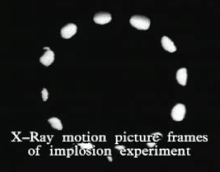RaLa Experiment
The experiment used significant amounts of a short-lived radioisotope lanthanum-140, a potent source of gamma radiation; the RaLa is a contraction of Radioactive Lanthanum.
The method was proposed by Robert Serber and developed by a team led by the Italian experimental physicist Bruno Rossi.
[2] In his history of the Los Alamos project, David Hawkins wrote: “RaLa became the most important single experiment affecting the final bomb design”.
The test measured changes of absorption of gamma rays in the metal of the sphere as it underwent compression.
The detectors had to provide high speed and large area; fast ionization chambers, then under development, were the only devices then available satisfying the requirements.
[1] A radiolanthanum sample, precipitated in a tip of a small cone, followed by a plug, was lowered into the center of the metal sphere of the experimental assembly with a device resembling a fishing rod.
The ionization chambers and their preamplifiers were destroyed during the explosion, but their simple design allowed their production in sufficient quantities.
Eight chambers were arranged in a tray and connected in parallel; four trays were located in a tetrahedron around the experimental assembly, recording the gamma radiation around the sphere, sufficiently close to give a signal and sufficiently far away to not be destroyed by the blast before they could record the required information.
The differences between the four traces on the oscilloscope display, each indicating the average compression in the direction of the detector, allowed the assessment of the required synchronization accuracy for the detonators.
One of the tanks was later lead-plated, sealed, equipped with self-contained air supply, and used for sampling of fission products in the post-blast debris after the Trinity test.
The chemists, who operated on mixtures of fission products with batches reaching up to 2,300 Ci (85 TBq) each, were frequently exposed (accidentally) to undesirably high doses of radiation.
[9] The experiments were performed in the Bayo Canyon in a location designated TA-10 ("Technical Area 10") (but more commonly referred to as the Bayo Canyon Site) in Los Alamos County and close to the border with Santa Fe County, northeast from the Los Alamos townsite.
[4] Bruno Rossi and Swiss physicist Hans Staub built the ionization chambers and electronics by late spring.
[4] At first the work proceeded at a leisurely pace as the implosion was only a backup project; it was believed that the plutonium bomb would be of the Thin Man gun-type fission weapon design.
This turned out not to be the case, as the first tests on reactor-produced plutonium in early summer 1944 showed unacceptably high spontaneous fission rates due to the presence of plutonium-240, precluding the use of gun assembly.
The program was delayed by about a month by late radiobarium shipments, as the test scheduled for 15 August was not conducted until mid-September.
[4] At the suggestion of Robert Christy solid spheres instead of the originally intended hollow ones were chosen for the pit, in order to reduce the problems with jets and spalling.
The electric detonators showed a significant improvement in the achieved compression degree and symmetry, and were used on all RaLa tests thereafter.
Barium was isolated in a purpose-built hot laboratory in Oak Ridge and shipped in a lead pig to Los Alamos, where it was used to extract lanthanum.
[15] At first the barium isolation was performed in building 3026-C (706-C), where an existing laboratory was converted for this purpose in 5 months; the first run was finished in September 1944.
By 1954 the shipments went up to 64,805 Ci (2.3978 PBq), and that year the AEC decided to build a new facility in Idaho National Laboratory for RaLa production.
In total, Oak Ridge processed over 30,000 uranium slugs and shipped over 500,000 Ci (19 PBq) to Los Alamos.
When the acid was added for the fourth batch, the violent reaction with the hot metal produced gases and forced the solution up the slug loading chute and the pipes.
[16] After delivery of the barium-lanthanum material to Los Alamos, it was stored in a dedicated building in the Bayo Canyon Site.
At first, the mixture was used as-is, both barium and lanthanum together, but this led to unpleasant radioactive contamination that took a long time to disappear as the half-life of barium-140 is 12.5 days.
The batches contained about 100 curies (3,700 GBq) of radiolanthanum, the highest radiation levels people had ever worked with at that time.
Semiautomatic equipment for "lanthanum milking" (the barium-140 isotope was nicknamed a "cow") was built in a sufficiently distant area, which avoided time-consuming construction of a heavily shielded building.
The flashes from 100 US gallons (380 L; 83 imp gal) of burning scintillator were remarkably brilliant in the early morning times when the tests were usually performed.
Other radioisotopes, present as impurities, have a long enough half-life to present a potential problem even decades after the tests; in 2002 the Los Alamos National Laboratory issued a warning to the Los Alamos county and the Forest Service performing thinning of trees in the area to not remove the trees cut in various parts of the Bayo Canyon due to possible content of residual radioactive materials.
[20] The worst affected zones are fenced off; detectable levels of radioisotopes are present in the soil, insects, and trees in the surrounding areas.


